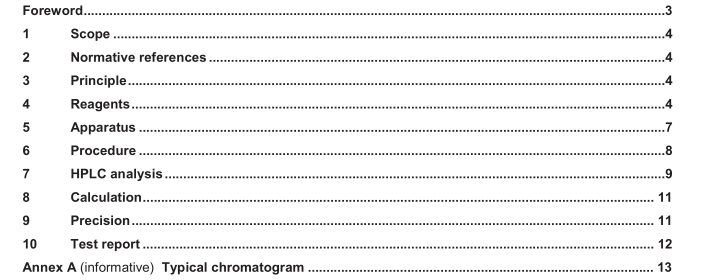EN 15851:2010 – Foodstuffs – Determination of aflatoxin B 1 in cereal based foods for infants and young children – HPLC method with immunoaffinity column cleanup and fluorescence detection

5.13 HPLC apparatus comprising the following:
5.13.1 Injection system, capable of injecting e.g. 1 000 µl. Total loop injection is recommended. In the case that a different volume is used, it shall be ensured that the limit of detection (LOD) for the system is ≤ 0,05 µg/kg (signal-to-noise-ratio = 3) and the limit of quantification (LOQ) is ≤ 0,1 µg/kg for aflatoxin B 1 .
The measurement of the LOQ shall be performed by multiple injection (n = 10) of a standard solution of aflatoxin B 1 (concentration equivalent to a contamination level of 0,1 µg/kg). The relative standard deviation (RSD) of the obtained signals shall not exceed a value of 10 %. This data shall be reported.
5.13.2 Mobile phase pump, capable of maintaining a volume flow rate of 1,0 ml/min. 5.13.3 Fluorescence detector, with a wavelength of λ = 360 nm excitation filter and a wavelength of λ > 420 nm cut-off emission filter, or equivalent (e.g. a detector with an adjustable monochromator). 5.13.4 Recorder, integrator or computer based data processing system.
5.13.5 Analytical reverse-phase HPLC separating column, e.g. C 18 or ODS-2, and a suitable corresponding reverse phase guard column. This column shall ensure a baseline resolved resolution of the aflatoxin B 1 peak from all other peaks.
The maximum overlapping of peaks shall be less than 10 % of the maximum peak height. It could be necessary to adjust the mobile phase for a sufficient baseline resolution. A suitable pre-column should be used.
5.13.6 Post-column derivatization system, with PBPB (only to be used with mobile phase A, see 4.21). Consisting of a second HPLC pulseless pump, zero-dead volume T-piece, reaction tubing of polytetrafluoroethylene (PTFE) with minimum 45 cm length and 0,5 mm internal diameter.
5.13.7 System for derivatization with electrochemically generated bromine, e.g. KOBRA cell ® 1) (only to be used with mobile phase B, see 4.22). Recommended settings for adjustable detectors are 365 nm (excitation wavelength), 435 nm (emission wavelength) and a bandwidth of 18 nm.
5.13.8 Degasser (optional).
5.14 UV spectrometer, with suitable quartz cells. 6 Procedure 6.1 Extraction Mix the sample thoroughly before removing an analytical test portion. Weigh, to the nearest 0,1 g, 50 g of the test portion of baby food (infant formula) into a 500 ml conical flask (5.5). Add 5 g of sodium chloride (4.8) and 250 ml of extraction solvent (4.19). Shake intensively by hand for the first 15 s to 30 s and then for 30 min with a shaker (5.3). Filter the extract using a prefolded filter paper (5.4) and, using a pipette (5.11), pipette 10 ml of the clear filtrate into a 100 ml calibrated volumetric flask (5.9) and fill up with PBS (4.13) to the mark. Re-filter through a glass microfibre filter (5.6) and transfer a volume of 50 ml to 100 ml of the clear filtrate on a reservoir (5.7) that is placed on a conditioned immunoaffinity column (see 4.25). Transfer the solution on column as described in 6.2.
EN 15851:2010 – Foodstuffs – Determination of aflatoxin B 1 in cereal based foods for infants and young children – HPLC method with immunoaffinity column cleanup and fluorescence detection